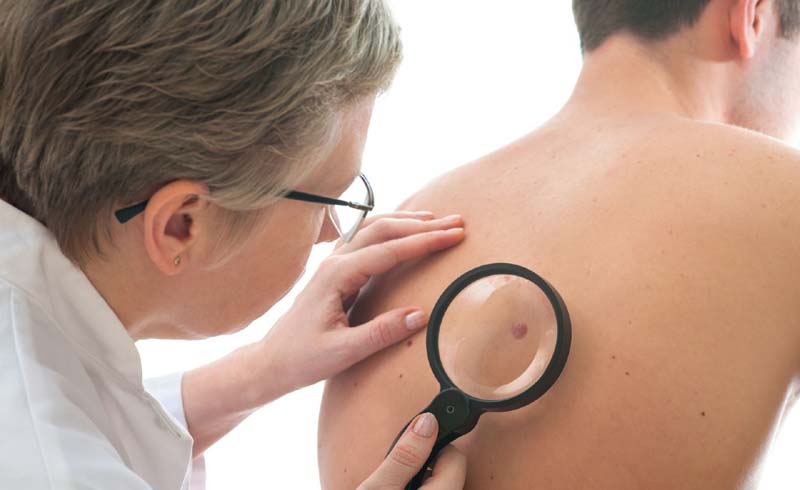Not all moles are beauty marks. Here's how to spot the warning signs of skin cancer and keep your moles in check.

From Redbook
New haircut, new job, new apartment — change is usually something to celebrate. One glaring exception: "New things on your skin tend to be bad," says Ranella Hirsch, M.D., a dermatologist and senior medical advisor to Vichy Laboratoires. And while not every new spot or mole will cause problems down the road, it's important to stay vigilant. If you spot any of these changes on yourself or a loved one, call your derm right away.
New haircut, new job, new apartment — change is usually something to celebrate. One glaring exception: "New things on your skin tend to be bad," says Ranella Hirsch, M.D., a dermatologist and senior medical advisor to Vichy Laboratoires. And while not every new spot or mole will cause problems down the road, it's important to stay vigilant. If you spot any of these changes on yourself or a loved one, call your derm right away.
First Things First: Check Him Out

I know: The idea of checking your partner for weird skin growths is about as unsexy as it gets. Even so, Hirsch suggests you scan his body monthly, and have him do the same for you. To make it feel a little less like a chore, "Give each other a massage," suggests Hirsch. That way, you'll automatically focus on the back, neck, and feet, but also spend time on areas you might miss in a quick once-over. "You're at the highest risk for basal and squamous cell cancers on places where the sun hits," says Hirsch. Translation: Check his face, ears, scalp (especially if his hair is thinning), arms, legs, and hands. (Don't forget fingernails — they're a surprising melanoma spot.)
Once a year, add your dermatologist into the mix for a more thorough exam. Because, as Hirsch puts it, "nothing's sexier than growing old together."
Look for Weird Red Bumps

Have a lingering red bump on your skin? It might be more serious than you think. "Basal cell cancers — the most common and slowest-growing — are often red bumps with raised edges that are a little pearly or translucent," says David Bank, M.D., a dermatologist in Mount Kisco, NY. "It might look like a pimple that won't go away."
Examine Sores That Won't Heal

Squamous cell carcinomas can take many different forms — from red patches to open sores — anywhere on your body, but pay close attention to spots that get a lot of sun exposure, like your ears, lower lip, face, neck, hands, arms, and legs. "Squamous cell cancers, which can metastasize if left untreated, are often reddish marks that will scab, flake off, then scab again," Bank says.
Use the ABCDE System

If you don't know about the ABCDE system yet, you should: It could save your life. "This system helps distinguish benign moles from malignant melanoma, the rarest but most lethal form of skin cancer," Bank says. By knowing your ABCDEs, you'll be able to determine differences in the size, shape, and color of your moles — and possibly spot a sign of cancer before it becomes serious. Here's exactly what to look out for, according to Bank:
A: Asymmetry

If you draw a line through the middle of a benign mole, the two halves will line up. Cancerous cells don't grow evenly.
B: Border

You should be able to easily tell where the mole stops compared to surrounding skin. A melanoma may have an ill-defined border that feathers off into the skin.
C: Color

Melanomas are often multicolored, while benign moles have a uniformity of color. The one exception: an all-black mole should raise a red flag, too.
D: Diameter

Melanomas tend to be around six millimeters, the size of a pencil eraser. Many benign moles are also bigger than that size, but few melanomas are smaller.
E: Evolving

Moles on the move can be malignant. Watch for a mole that changes color, raises up, gets itchy, or gets larger. Notice a shifting spot? Call your derm right away.
![[feature] dermatologist,sun protection,skin cancer,Mole,mole check,signs of melanoma,what skin cancer looks like,skin cancer warning signs](https://blogger.googleusercontent.com/img/b/R29vZ2xl/AVvXsEj2qxMXvFiAEE49hmFFdONdhiqfl4bRk38t1LsAjG6ubmtopMuRdlc249GGyt-nh0bLsxWz_WkxB06LAVJAqkDe2hlJ5jMpi-Bk_HhmM-0plEP1PiK7YdAZYzGGLZuFq_uES9V5BelWuhyphenhyphenH/s1600-rw/dearjulius.com01.jpg)
























